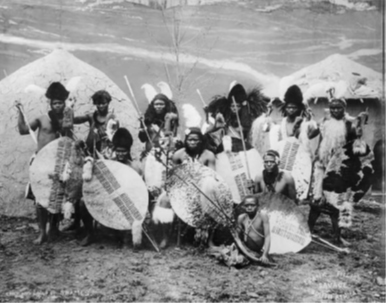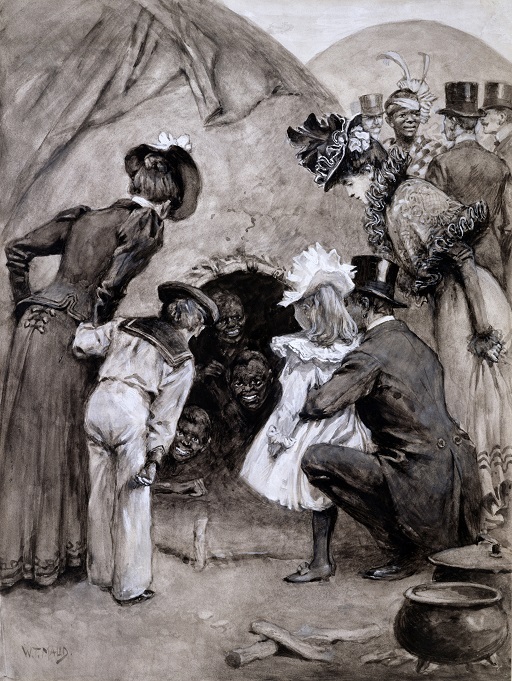3 Reinforcing colonial stereotypes about Africa: Savage South Africa
Savage South Africa was a human exhibition in London’s Earl’s Court exhibition centre from 1899–1900. It was typical of the lavish entertainment designed to celebrate the triumph of European empires. By 1900 Europeans controlled 90% of the African continent and 1 in 3 Africans were British colonial subjects (Olusoga, 2016, p. 401). Produced by South African circus owner Frank Fillis, the ‘Horde of Savages’ show was advertised as the chance to see ‘Africa’ and dramatic re-enactments of the 1893–1894 Anglo-Ndebele War that had been fought in Matabeleland and Mashonaland (Qureshi, 2011, p. 250). These territories became part of Rhodesia and today are regions of Zimbabwe.
Twice a day, amid the tightrope and equestrian acts, seated spectators were reminded of European superiority as 200 Africans, armed with shields and spears, were outmatched by 20 British South Africa Company soldiers with guns, who were played by the Boers (Dutch settler colonialists) in the troupe. In between the performances spectators watched, from behind fences, ‘native’ life in the mock African village (see Figure 4). The Black human exhibits, wearing costumes Fillis designed, performing the ceremonies he instructed and eating the food he prescribed, were constantly supervised.
When frustration on the part of the British ‘exhibits’ led to overt resistance and violence, the human ‘exhibits’ were granted limited freedom to walk around the show grounds. The Aborigines’ Protection Society protests against the exploitative blurring of the performers’ working and living conditions received little public sympathy. The exhibits were hugely popular with Victorians keen to view the latest enemy in the European Partition of Africa.

The demise of the Savage South Africa show was partly due to the mistaken belief in racial biological difference and racial hierarchy. The thought of racial mixing horrified most Victorians. The international press was initially scandalised by the rumoured sexual relations between white women and Black men who were part of the human exhibit, and this led to a ban of female visitors to the mock village. The show closed following damning reports of the marriage of a Black performer (said to be Peter Lobengula, the son of the defeated Ndebele king) and an English woman – Kitty Jewell. They soon divorced and, in 1902, Peter married the Irish woman Lily Magowan. They settled in Lancashire, and had five children before Peter died in 1913.
In 1900 Fillis took the show on a national tour, but its re-enactments no longer interested a public gripped by Britain’s war with the Boers in South Africa (1899–1902).
Activity 1
Visual images are a valuable source of historical evidence and historical context is important to their interpretation. Examine Figure 5 closely, consider the information in the caption, then answer the following question:
- Drawing on the historical context provided above, how does the image in Figure 5 contribute to the study of nineteenth-century human exhibitions?
It is helpful to begin your answer by identifying what you can see.
Discussion
The image appears to depict a Victorian family touring the Savage South Africa mock village at Earl’s Court, London in June 1899. The family members lean towards a mock African hut and meet the gaze of three Africans. In the background stand men in top hats, apparently conversing with a Black person who was part of the human exhibit.
The image is from the Graphic newspaper. It was published the year the show opened, and was likely produced for promotional purposes. It suggests the exhibition was the opportunity for spectators to ‘peep at the natives’ in authentic surroundings. The hinted conversation, top right, suggests visitors with an interest in anthropology may also meet the exhibits. The African’s headgear is reminiscent of the costumes in Figure 4. It is valuable to cross-reference the image with the photograph in Figure 4, also from 1899. In neither image are the full troupe of 200 African performers shown, and the 20 Boers are also missing. Perhaps this reflects the draw of a personal encounter with an African ‘native’.
The image strongly captures the erroneous racial stereotypes that informed and drove imperial expansion in the late nineteenth century. The portrayal of Black people in the hut reflects contemporary Victorian stereotypes of Africans, with their childlike expressions. The British family is well dressed, symbolic of the power and supposed superiority of Europeans over the ‘savages’ crouching, presumed naked, in the darkness. Africa was routinely referred to as the ‘Dark Continent’ at this time.
The image does not fully convey the exhibition’s racialised structures. The fences limiting interaction between the Africans and spectators are absent. Nor are there clues of the strict supervision of Black performers.
It is worth considering how language can be used to describe humans in exhibitions. ‘Performer’ recognises their status as paid re-enactors. ‘Exhibit’ more accurately reflects their lack of agency.

